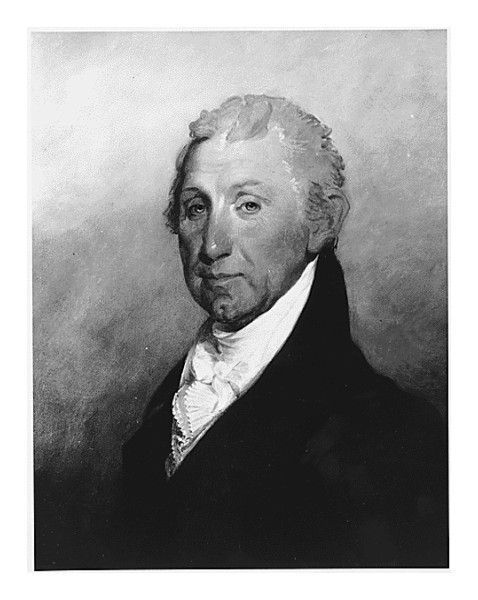
Image above: President James Monroe. Image right: Triumph, depicting eventual victory of Union, with reference to the Missouri Compromise. Created by Morris H. Traubel, 1861. Images courtesy Library of Congress.
Sponsor this page for $75 per year. Your banner or text ad can fill the space above.
Click here to Sponsor the page and how to reserve your ad.
-
Timeline
1829 Detail
February 26, 1829 - Levi Strauss, American clothing designer and jeans entrepreneur, is born. He would be credited with manufacturing the first blue jeans.

Okay, so the date of his birth is less important than the impact his tough clothing would have on American society. We'll give you that. However, when Levi Strauss was born in the Kingdom of Bavaria, German Confederation (no nation of Germany yet) on this date as Lob Straub, it would set in motion an emigration to New York City, the trip to San Francisco, followed by work clothes for Gold Rush era miners, albeit not the riveted blue jeans yet, and then two decades later, a fashion staple for the next one hundred and fifty years or so. So whether this date, or one in 1854, or one in 1873, should be celebrated more, is somewhat irrelevent. So let's take the journey from Bavaria to San Francisco with Levi Strauss and find out just how he eventually got his blue jeans into almost every store in the United States.
Brothers Jonas and Louis had already emigrated to New York City and opened a dry good supply store, J Strauss Brother and Company, by the time eighteen year old Levi joined them in 1847 with his mother and two sisters. Levi immediately began to assist in the dry goods business, eventually traveling to Louisville, Kentucky to sell his brothers wares. In 1853, with the Gold Rush in California causing a rush in the need for supplies as the area grew in population, Levi Strauss took a steamship to San Francisco, arriving in March 1853, and established Levi Strauss & Company at 90 Sacramento Street, again selling his brothers supplies as well as other goods. That expanded over time to include tents and jeans, then known as overalls.
But how did what we deem blue jeans, those jeans with rivets, actually begin? It took a couple decades for Levi Strauss to come up with manufacture of those items. And it took a customer, Jacob W. Davis, to invent them.
Invention of the Blue Jeans
Jacob W. Davis is not well known. He was a tailor born in Riga, Latvia as Jacob Youphes who emigrated to New York City in 1854. Eventually, he followed a similar path as Strauss, traveling west to San Francisco in 1856. Once on the west coast, Davis became itinerant, moving to Canada to pan gold, to Nevada in sales, then back to his job as a tailor in Reno in 1869. He began to craft durable goods for the railroad workers of the Central Pacific, including tents, horse blankets, wagon covers, and tough jeans reinforced with copper rivets. He bought the heavy duty denim from Levi Strauss. Customers from woodcutters to railroad workers were so enamored with the toughness of the duck cloth and denim jeans with rivets, first sewn in 1870, that Jacob Davis could not keep up with the demand.
Davis knew that his invention had remarkable value, and that a patent should be secured, but did not have the finances to make a patent application. He asked Levi Strauss in 1872 whether they could apply together with his financial assistance. On May 20. 1873, US Patent No. 139,121 was issued to Davis and Strauss. They also registered a trade mark for the unique back pocket stitching that would distinguish them.
Davis/Strauss Patent 139,121
UNITED STATES PATENT OFFICE. JACOB W. DAVIS, OF RENO, NEVADA, ASSIGNOR TO HIMSELF AND LEVI STRAUSS & COMPANY, OF SAN FRANCISCO, CALIFORNIA.
IMPROVEMENT IN FASTENING POCKET-OPENINGS.
Specification forming part of Letters Patent No. 139,121, dated May 20, 1873 application filed August 9, 1872.
To all whom at may concern Be it known that I, JACOB W. DAVIS, of Reno, county of Washoe and State of Nevada, have invented an Improvement in Fastening Scams; and I do hereby declare the following description and accompanying drawing are sutficient to enable any person skilled in the art or science to which it most nearly appertains to make and use my said invention or improvement without further invention or experiment; My invention relates to a fastening for pocket-openings, whereby; the sewed seams are prevented from ripping or starting from frequent pressure or strain thereon; and it consists in the employment of a metal rivet or eyelet at each edge of the pocket-opening, to prevent the rippingof the seam at those points. The rivet or eyelet is so fastened in the seam as to bind the two parts of cloth which the seam unites together, so that it shall prevent the strain or pressure from coming upon the thread with which the seam is sewed.
In order to more fully illustrate and explain my invention, reference is had to the accompanying drawing, in which my invention is represented as applied to the pockets of a pair of pants.
Figure 1 is a view of my invention as applied to pants.
A is the side seam in a pair of pants, drawers, or other article of wearing apparel, which terminates at the pockets; and b b represent the rivets at each edge of the pocket opening. The seams are usually ripped or started by the placing of the hands in the pockets and the consequent pressure or strain upon them. To strengthen this part I employ a rivet, eyelet, or other equivalent meta-l stud, b, which I pass through a hole at the end of the seam, so as to bind the two parts of cloth together, and then head'it down upon both sides so as to firmly unite the two parts. which already have one head are used, it is only necessary to head the opposite end, and a washer can be interposed, if desired, in the usual way. By this means I avoid a large amount oftrouble in mending portions of seams which are subjected to constant strain.
I am aware that rivets have been used for securing seams in shoes, as shown in the patents to Geo. Houghton, No; 6i,0l5, April 23, 1867, and to L. K. Washburn, No. 123,313,
January 30, 1872; and hence I do not claim, broadly, fastening of seams by means of rivets.
Having thus described my invention, what I claim as new, and esire to secure by Letters Patent, is -
As a new article of manufacture, a pair of pantaloons having the pocket-openings secured at each edge by means of rivets, substantially in the manner described and shown, whereby the seams at the points named are prevented from ripping, as set forth.
In witness whereof I hereunto set my hand and seal.
JACOB W. DAVIS. [L.S.]
Witnesses:
JAMES C. HAGERMAN,
W. BERGMAN.
The Manufacture of Blue Jeans
Levi Strauss opened up a large tailor shop in San Francisco, moving Davis back to the city to manufacture their new product, which were originally known as waist overalls. That shop was outgrown quickly, causing the need for Strauss to open a manufacturing plant for his overalls, which Davis also managed. In the 1890's, Levi's 501 Jeans were designed, but the popularity of the denim pants were predominanty confined to working men on the west coast. It's popularity began to grow slowly nationally. In the 1930's a dude ranch craze saw vacationers bringing them back east. In World War II, they were considered essential for defense workers due to their durability. It was not, however, until the 1960's and 1970's that the casual appearance of clothing at work and play caused a significant growth in the Levi brand and referring to them as "jeans" was used by customers.
Between 1964 and 1974, production increased from sixteen manufacting plants in the United States to sixty-three, not including twenty-three additional plants worldwide. In 1946, the company had fifteen sales people; by 1976, it had twenty-two thousand.
Since it's growth in the 1960's and 1970's, Levi Strauss and Company has undergone many changes, factory closures, and brand competition in the marketplace, but remains an over $5 billion dollar business, with apparel contracts through Walmart and other retailers. In 2018, it still employed over fifteen thousand people.
Image above: Montage (left) photo of Levi Strauss. Courtesy Wikipedia Commons; (right) Trademarked pocket design tag of Levi's, 2006, Ludovic Glucksman. Courtesy Wikipedia Commons CC1.0. Image below: Montage (left) Jacob W. Davis, circa 1905. Courtesy Wikipedia Commons; (right) Wall advertisement for the company in Woodland, California, 2011, Jim Heaphy. Courtesy Wikipedia Commons CC3.0. Source Info: Levistrauss.com; Google Patents; ipwatchdog.com; Wikipedia Commons.







